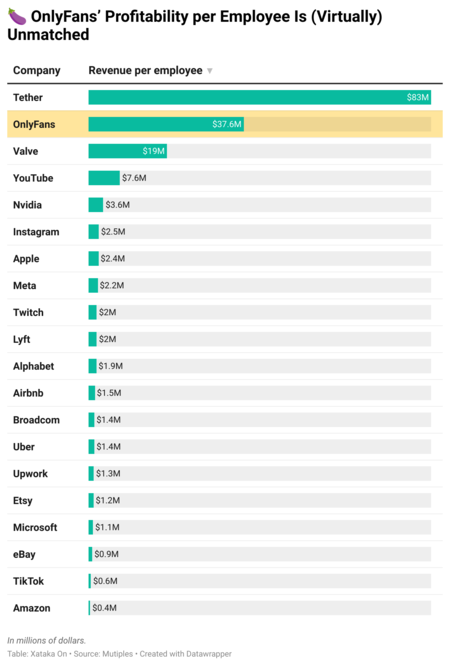According to a detailed report published by Multiples, OnlyFans generates $37.6 million per employee when its revenue is divided by its total workforce.
This figure dwarfs any comparison with tech giants.
Why it matters. The adult content platform has perfected what much of the tech industry struggles with: extracting maximum value using minimal resources.
Apple generates $2.4 million per employee. Meta comes in at $2.2 million. Amazon generates just $400,000 per employee.

In numbers. Only Tether, a cryptocurrency company, beats OnlyFans with $83 million per employee. Then comes OnlyFans. After that, there’s a massive gap until Valve, which generates $19 million per employee. The rest of the big tech players lag far behind.
- OnlyFans increased its revenue by leveraging a mix of influencers and cryptocurrencies just two years ago.
The model. With just a few hundred employees, OnlyFans manages 315 million users and 5.3 million creators—essentially operating as a money-printing machine. Its profit margin was nearly 49% in 2024, and net revenues reached $1.6 billion.
The company keeps 20% of everything creators earn. It doesn’t produce content, take creative risks or maintain large tech infrastructures. It’s pure intermediation—optimized to the extreme.
Yes, but... OnlyFans dominates a fiercely concentrated market.
- Seventy percent of payments go to the top 10% of creators.
- The average creator earns less than $150 a month.
- It’s a ruthless marketplace where a few make fortunes, and the majority scrape by.
Between the lines. While big tech companies employ massive teams of engineers, designers, and executives to compete for attention, OnlyFans solved the problem differently. It created a space where consumers pay directly for specific content. There are no complex algorithms, no exhaustive moderation, no ad-driven competition.
The company now seeks a valuation of $8 billion—just 10 times its annual profits, a conservative figure by tech standards.
But OnlyFans isn’t just any tech company. It’s the clearest example yet that efficiency matters more than size. Pun intended.
Image | Connor McManus



